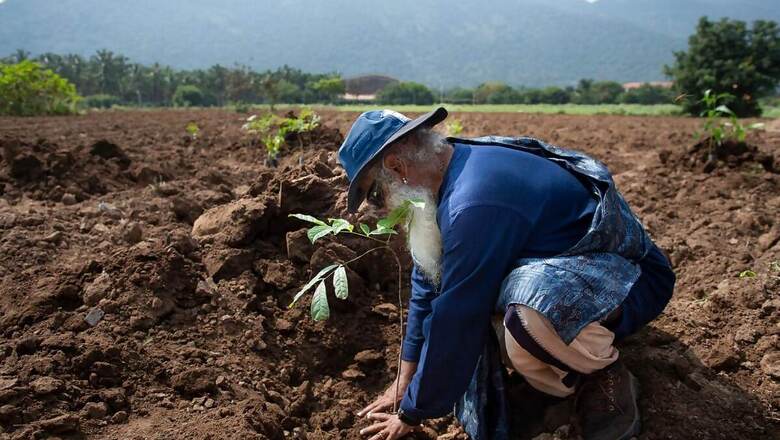
views
Right now, the United Nations Convention to Combat Desertification (UNCCD) is very concerned about India, because our soil is dying. When we say soil, we are largely talking about the topsoil. On an average, there are thirty-nine inches of topsoil in the world. Almost all life happens because of these thirty-nine inches.
Southern India is largely considered a blessed land because of how rich the soil is. This is the reason why there is a history of over 12,000 years of agriculture in this region. If you have been to the Western Ghats, if you just pick up a handful of soil, you will see it is bursting with life. That is how soil should be. But right now, if you are flying from Chennai to Delhi and you look out of the window, except a few green patches here and there, India looks like a brown desert.
Over 300,000 farmers have committed suicide in a matter of twenty years in our country. The usual explanation is that the farmer killed himself because he could not pay back his bank loan. But suppose you were a farmer and you had land with rich soil and abundant water, no matter what the situation, would you commit suicide? Definitely not. Right now, the distress is caused because the soil is so poor. The question is, why did it become poor?
The Only Ingredient – Organic Content
You can keep the soil rich only by putting organic content into it. We think the soil will be fine just by putting fertilizer salts. For all those people who do not understand what I am saying, let’s say for your next meal, make it ninety percent salt and ten percent of whatever else you want to eat. Then you will understand what you are doing to this soil and the country.
It is very important to understand that when you harvest some crop – let’s say a ton of sugarcane – what you have taken out is a ton of topsoil. You need to put the organic matter back into the soil. The only way to do this is with leaves from the trees or with animal waste. There are no animals on the farm because they are all traveling abroad to be eaten! And the trees have gone a long time ago. People think a tractor will do the job. A tractor will plow the soil, but it will not enrich the soil as animals and trees would.
If we want to stop and reverse this desertification, we need to bring the soil in the nation under tree shade. There is no question of bringing back forests because of the population pressure on the land. The only way to do it is through agriculture because the majority of India’s land is in the hands of the farmer. If we create a process where tree planting is lucrative for the farmer, he will put back these trees.
This is where Cauvery Calling comes in. From what I have seen, most ecological efforts are all about propagating philosophies. But Cauvery Calling is an ecological effort with a solid economic background. In Cauvery Calling, trees are going into private farmlands. We have already converted 69,760 farmers in the Cauvery basin to agroforestry, and their incomes have gone up anywhere between 300 to 800 percent. Taking care of the trees is in the commercial interest of the farmer, so he naturally ensures they grow.
This is an economic plan with an ecological impact – that’s what is important about it. This is the reason why right from farmers, to the forest officers and the state governments, they are all participating in Cauvery Calling with great enthusiasm and responsibility. They clearly see that this is a game-changer, and they want to be a part of it. Even the pandemic could not slow us down in any way. With their support, we were able to get 1.12 crore saplings ready to be distributed to farmers despite the challenging situation.
Ensuring Our Food Security
One of the greatest achievements of this nation is that we are managing to provide food for nearly 1.4 billion people without any major imports. Even in a situation like the current pandemic, we have enough food for everyone. Our farmers have done a fantastic job, with no great technology or science, just with traditional knowledge.
Unfortunately, what we have found when we conducted some rudimentary surveys was that not even two percent of the farming community wants their children to go into farming. In another twenty-five years when this generation passes, who will grow food for you? Nearly sixty-five percent of our population knows how to conduct this magic of turning mud into food, which is not a simple thing.
If I give ten acres of very fertile land to someone – even if they are an MBA or agricultural graduate – and ask them to grow ten different crops, it will be a total failure. Just because the farmer looks illiterate, undernourished and badly dressed, people think agriculture is unimportant. It is not. Farming is a very complex and time sensitive operation. Unfortunately we may lose that knowledge, unless farming becomes lucrative for the farmer. It is time educated people invest and invest their children into farming because with today’s science and technology, it can be done profitably and sustainably.
If we can bring these changes into farming, we can fix the soil, the water, air and everything else necessary to live a healthy life. The greatest legacy we can leave for our children is an environment of rich soil and water. Only in preserving the quality of the soil, the quality of the planet and life will endure.
Ranked amongst the 50 most influential people in India, Sadhguru is a yogi, mystic, visionary and a New York Times bestselling author Sadhguru has been conferred the Padma Vibhushan by the Government of India in 2017, the highest annual civilian award, accorded for exceptional and distinguished service.




















Comments
0 comment